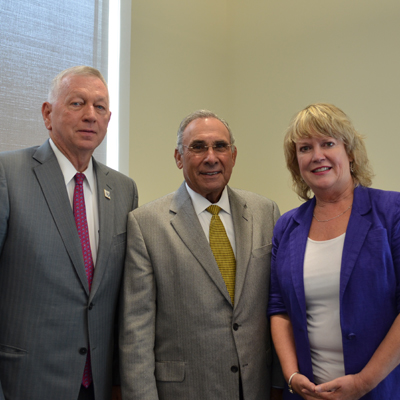Galveston officials visit TAMUG
Tweet Newly-elected Galveston Mayor Lewis Rosen and Galveston Councilwoman Marie Robb recently visited TAMUG for a briefing about the campus. The city officials were interested in obtaining an overview of the university as well as specific information about fire protection, police services and traffic concerns on the Pelican Island campus, which is part of the City of Galveston.
Newly-elected Galveston Mayor Lewis Rosen and Galveston Councilwoman Marie Robb recently visited TAMUG for a briefing about the campus. The city officials were interested in obtaining an overview of the university as well as specific information about fire protection, police services and traffic concerns on the Pelican Island campus, which is part of the City of Galveston.
Touting a tier-one university
Rear Admiral Robert Smith III, president of TAMUG and Dr. William Seitz, associate provost, Texas A&M University (TAMU) and senior vice president and chief academic officer at TAMUG provided city officials with a briefing about TAMUG as a legislatively-designated special purpose marine and maritime campus. Rear Admiral Smith noted that TAMUG is considered a tier-one (top national research) university, and as such, adds value to the city.
Various TAMUG leaders delivered presentations about the progress of scientific and engineering endeavors that could be mutually beneficial for Galveston, the Greater Houston area and the State of Texas. Presentations were also provided about TAMUG’s outreach programs, which serve the community and TAMUG facilities, which serve a growing student population.
Proposing the Ike Dike
Dr. William “Bill” Merrell, professor of Marine Biology, offered an update on the status of the Ike Dike initiative — a proposed project to construct a “coastal spine” intended to protect Galveston and the Greater Houston area from hurricanes. It was noted that the Ike Dike could save thousands of lives and millions of dollars in the region, not to mention protect oil reserves, which are the power of energy and defense of the nation.
Protecting from flooding
Dr. Samuel Brody demonstrated a web-based Texas Communities Coastal Atlas that could help protect the citizens of Galveston as well as Texas coastal areas from the impact of flooding. Brody is holder of the George P. Mitchell '40 Chair in Sustainable Coasts, and director of the Center for Texas Beaches and Shores, Department of Marine Sciences at Galveston, Department of Landscape Architecture & Urban Planning at College Station Texas A&M University at College Station. The Texas A&M Board of Regents recently tapped him to become the director of the newly-created Institute for Sustainable Coastal Communities.
Teaching the community
One of the most well-known outreach programs in Texas, TAMUG’s Sea Camp, provides marine adventures for students from age 10 to 18 and opportunities for teachers to learn more about techniques for teaching marine-related subjects. Dr. Donna Lang, vice president for Academic Affairs, provided a presentation about TAMUG’s outreach programs such as Sea Camp. Lang noted that more than 1,520 students attended Sea Camp this summer. In addition to Sea Camp, the university sponsors numerous marine-education and environmental field trips for local school, scouting and church groups as well as opportunities for teachers to obtain state-approved credit hours. TAMUG also offers a “Road Scholars” program of life-long learning for those aged 55 and over.
Growing the population, building for the future
With a projected student population of 2,100 students, including an anticipated record-breaking number of 400 Corps of Cadets students, some of the newest citizens of Galveston are living on Pelican Island. Grant Shallenberger, associate vice president for Student Affairs and Auxiliary Services provided the mayor with information about campus preparations to accommodate housing needs of students. He noted that two news residence halls constructed at a cost of $28.2 million, will open this fall. The facilities will offer an additional 588 beds. TAMUG is in charge of seven residence halls housing more than 1,000 students.
The TAMUG briefing offered opportunities for city and university officials to discuss safety and services for Galvestonians residing on the TAMUG campus . It also provided a venue to showcase university outreach services as well as TAMUG scientific endeavors to enrich and protect the local community.
###